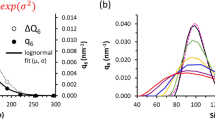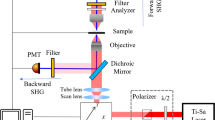Abstract
The biomechanical properties of living cells depend on their molecular building blocks, and are important for maintaining structure and function in cells, the extracellular matrix, and tissues. These biomechanical properties and forces also shape and modify the cellular and extracellular structures under stress. While many studies have investigated the biomechanics of single cells or small populations of cells in culture, or the properties of organs and tissues, few studies have investigated the biomechanics of complex cell populations in vivo. With the use of advanced multiphoton microscopy to visualize in vivo cell populations in human skin, the biomechanical properties are investigated in a depth-dependent manner in the stratum corneum and epidermis using quasi-static mechanical deformations. A 2D elastic registration algorithm was used to analyze the images before and after deformation to determine displacements in different skin layers. In this feasibility study, the images and results from one human subject demonstrate the potential of the technique for revealing differences in elastic properties between the stratum corneum and the rest of the epidermis. This interrogational imaging methodology has the potential to enable a wide range of investigations for understanding how the biomechanical properties of in vivo cell populations influence function in health and disease.





Similar content being viewed by others
References
Agache, P., and P. Humbert. Measuring the Skin. Berlin: Springer-Verlag, pp. 96–98, 2004.
Bao, G., and S. Suresh. Cell and molecular mechanics of biological materials. Nat. Mater. 2:715–725, 2003.
Canadas, P., V. M. Laurent, C. Oddou, D. Isabey, and S. Wendling. A cellular tensegrity model to analyse the structural viscoelasticity of the cytoskeleton. J. Theor. Biol. 218:155–173, 2002.
Chen, J., B. Fabry, E. L. Schiffrin, and N. Wang. Twisting integrin receptors increases endothelin-1 gene expression in endothelial cells. Am. J. Physiol. Cell Physiol. 280:C1475–C1484, 2001.
Coughlin, M. F., and D. Stamenovic. A tensegrity structure with buckling compression elements: application to cell mechanics. Trans. ASME 64:480–486, 1997.
Curiel-Lewandrowski, C., C. M. Williams, K. J. Swindells, S. R. Tahan, S. Astner, R. A. Frankenthaler, and S. González. Use of in vivo confocal microscopy in malignant melanoma: an aid in diagnosis and assessment of surgical and nonsurgical therapeutic approaches. Arch. Dermatol. 140:1127–1132, 2004.
Dimitrow, E., M. Ziemer, M. J. Koehler, J. Norgauer, K. König, P. Elsner, and M. Kaatz. Sensitivity and specificity of multiphoton laser tomography for in vivo and ex vivo diagnosis of malignant melanoma. J. Invest. Dermatol. 129:1752–1758, 2009.
Diridollou, S., M. Berson, V. Vabre, D. Black, B. Karlsson, F. Auriol, J. M. Gregoire, C. Yvon, L. Vaillant, Y. Gall, and F. Patat. An in vivo method for measuring the mechanical properties of the skin using ultrasound. Ultrasound. Med. Biol. 24:215–224, 1997.
Ericson, M. B., C. Simonsson, S. Guldbrand, C. Ljungblad, J. Paoli, and M. Smedh. Two-photon laser-scanning fluorescence microscopy applied for studies of human skin. J. Biophoton. 1:320–330, 2008.
Evans, E., and A. Yeung. Apparent viscosity and cortical tension of blood granulocytes determined by micropipet aspiration. Biophys. J. 56:151–160, 1989.
Graf, B. W., Z. Jiang, H. Tu, and S. A. Boppart. Dual-spectrum laser source based on fiber continuum generation for integrated optical coherence and multiphoton microscopy. J. Biomed. Opt. 14:034019, 2009.
Ingber, D. E. Mechanical signaling and the cellular response to extracellular matrix in angiogenesis and cardiovascular physiology. Circ. Res. 91:877–887, 2002.
Koehler, M. J., K. König, P. Elsner, R. Bückle, and M. Kaatz. In vivo assessment of human skin aging by multiphoton laser scanning tomography. Opt. Lett. 31:2879–2881, 2006.
König, K., A. Ehlers, F. Stracke, and I. Riemann. In vivo drug screening in human skin using femtosecond laser multiphoton tomography. Skin Pharmacol. Physiol. 19:78–88, 2006.
König, K., and I. Riemann. High-resolution multiphoton tomography of human skin with subcellular spatial resolution and picosecond time resolution. J. Biomed. Opt. 8:432–439, 2003.
Krehbiel, J., J. Lambros, J. Viator, and N. R. Sottos. Digital image correlation for improved detection of basal cell carcinoma. Exp. Mech. 2009. doi:10.1004/s11340-009-9324-8.
Langer, K. On the anatomy and physiology of the skin I. The cleavability of the cutis. Br. J. Plast. Surg. 31:3–8, 1978.
Liang, X., and S. A. Boppart. Biomechanical properties of in vivo human skin from dynamic optical coherence elastography. IEEE Trans. Biomed. Eng. 57:953–959, 2010.
Liang, X., B. W. Graf, and S. A. Boppart. Multimodality microscopy for imaging three-dimensional engineered and natural tissues. J. Biophoton. 2:643–655, 2009.
Liu, Z., N. J. Sniadecki, and C. S. Chen. Mechanical forces in endothelial cells during firm adhesion and early transmigration of human monocytes. Cell. Mol. Bioeng. 3:50–59, 2010.
Mann, C., and D. Leckband. Measuring traction forces in long-term cell cultures. Cell. Mol. Bioeng. 3:40–49, 2010.
Marcellier, H., P. Vescovo, D. Varchon, P. Vacher, and P. Humbert. Optical analysis of displacement and strain fields on human skin. Skin Res. Technol. 7:246–253, 2001.
Mathur, A. B., A. M. Collinsworth, W. M. Reichert, W. E. Kraus, and G. A. Truskey. Endothelial, cardiac muscle and skeletal muscle exhibit different viscous and elastic properties as determined by atomic force microscopy. J. Biomech. 34:1545–1553, 2001.
Pena, A., M. Strupler, T. Boulesteix, and M. Schanne-Klein. Spectroscopic analysis of keratin endogenous signal for skin multiphoton microscopy. Opt. Express 13:6268–6274, 2005.
Rajadhyaksha, M., S. González, J. M. Zavislan, R. R. Anderson, and R. H. Webb. In vivo confocal scanning laser microscopy of human skin II: advances in instrumentation and comparison with histology. J. Invest. Dermatol. 113:293–303, 1999.
Sánchez Sorzano, C. Ó., P. Thévenaz, and M. Unser. Elastic registration of biological images using vector-Spline regularization. IEEE Trans. Biomed. Eng. 52:652–663, 2005.
Satcher, R. L., and C. F. Dewey, Jr. Theoretical estimates of mechanical properties of the endothelial cell cytoskeleton. Biophys. J. 71:109–118, 1996.
Staloff, I. A., E. Guan, S. Katz, M. Rafailovitch, A. Sokolov, and S. Sokolov. An in vivo study of the mechanical properties of facial skin and influence of aging using digital image speckle correlation. Skin Res. Technol. 14:127–134, 2008.
Svoboda, K., and S. M. Block. Biological applications of optical forces. Annu. Rev. Biophys. Biomol. Struct. 23:247–285, 1994.
Verdier-Sevrain, S., and B. Frederic. Skin hydration: a review on its molecular mechanisms. J. Cosmet. Dermatol. 6:75–82, 2007.
Vinegoni, C., T. S. Ralston, W. Tan, W. Luo, D. L. Marks, and S. A. Boppart. Integrated structural and functional optical imaging combining spectral-domain optical coherence and multiphoton microscopy. Appl. Phys. Lett. 88:053901, 2006.
Acknowledgments
We thank Dr. Haohua Tu and Eric Chaney for their laboratory assistance and thank Dr. Steven G. Adie for insightful discussions. This work was supported in part by grants from the National Institutes of Health (R01 EB005221 and RC1 CA147096) and the National Science Foundation (CBET 08-52658). Additional information can be found at http://biophotonics.illinois.edu.
Author information
Authors and Affiliations
Corresponding author
Additional information
Associate Editor Yingxiao Wang Peter J. Butler oversaw the review of this article.
Rights and permissions
About this article
Cite this article
Liang, X., Graf, B.W. & Boppart, S.A. In Vivo Multiphoton Microscopy for Investigating Biomechanical Properties of Human Skin. Cel. Mol. Bioeng. 4, 231–238 (2011). https://doi.org/10.1007/s12195-010-0147-6
Received:
Accepted:
Published:
Issue Date:
DOI: https://doi.org/10.1007/s12195-010-0147-6




